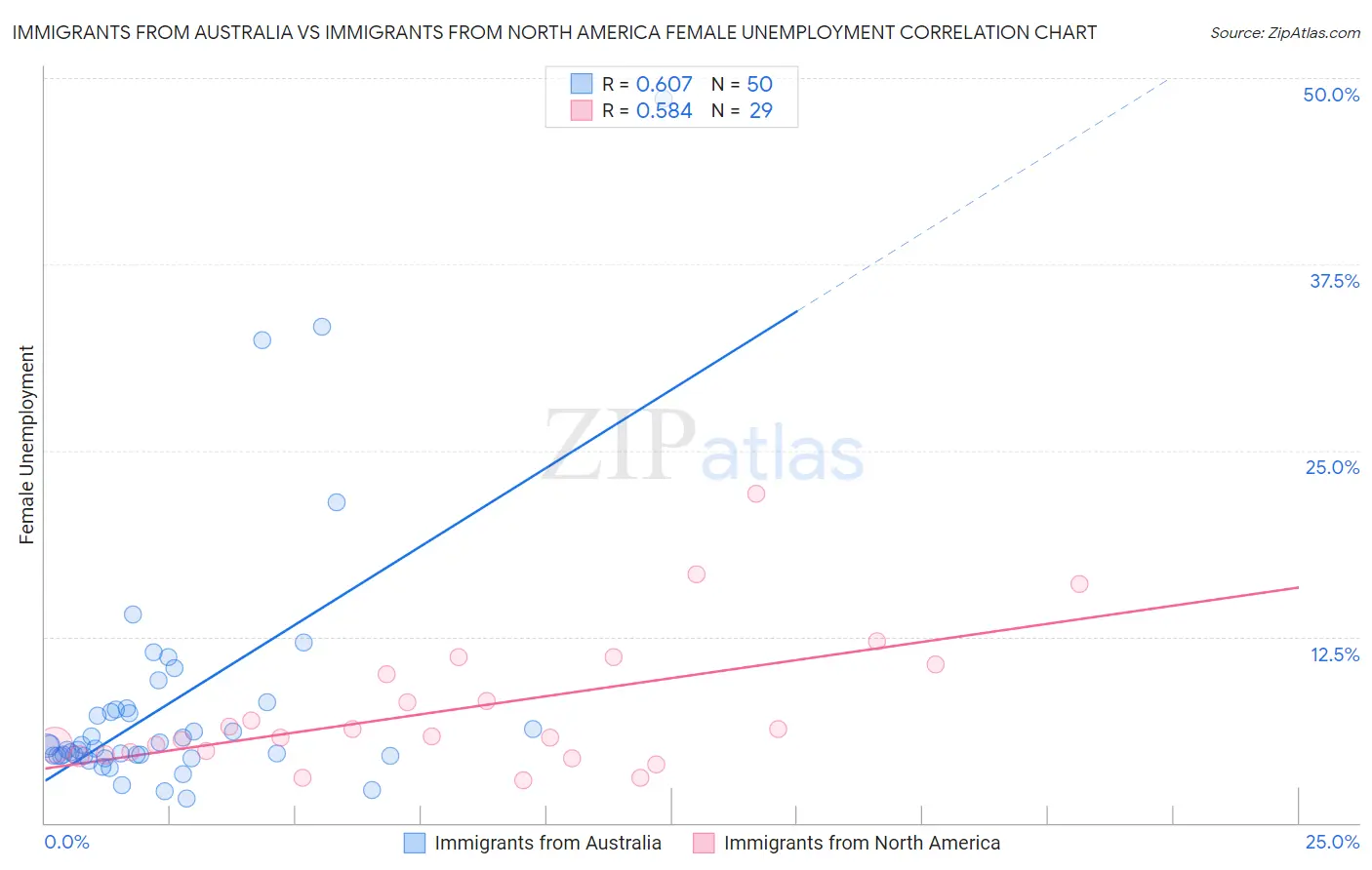Immigrants from Australia vs Immigrants from North America Female Unemployment
COMPARE
Immigrants from Australia
Immigrants from North America
Female Unemployment
Female Unemployment Comparison
Immigrants from Australia
Immigrants from North America
5.0%
FEMALE UNEMPLOYMENT
97.3/ 100
METRIC RATING
82nd/ 347
METRIC RANK
4.9%
FEMALE UNEMPLOYMENT
98.3/ 100
METRIC RATING
65th/ 347
METRIC RANK
Immigrants from Australia vs Immigrants from North America Female Unemployment Correlation Chart
The statistical analysis conducted on geographies consisting of 226,659,190 people shows a significant positive correlation between the proportion of Immigrants from Australia and unemploymnet rate among females in the United States with a correlation coefficient (R) of 0.607 and weighted average of 5.0%. Similarly, the statistical analysis conducted on geographies consisting of 458,145,875 people shows a substantial positive correlation between the proportion of Immigrants from North America and unemploymnet rate among females in the United States with a correlation coefficient (R) of 0.584 and weighted average of 4.9%, a difference of 0.78%.

Female Unemployment Correlation Summary
| Measurement | Immigrants from Australia | Immigrants from North America |
| Minimum | 1.6% | 2.9% |
| Maximum | 48.6% | 22.1% |
| Range | 47.0% | 19.2% |
| Mean | 8.1% | 7.6% |
| Median | 5.1% | 5.8% |
| Interquartile 25% (IQ1) | 4.5% | 4.6% |
| Interquartile 75% (IQ3) | 7.6% | 10.3% |
| Interquartile Range (IQR) | 3.1% | 5.7% |
| Standard Deviation (Sample) | 8.6% | 4.5% |
| Standard Deviation (Population) | 8.5% | 4.5% |
Demographics Similar to Immigrants from Australia and Immigrants from North America by Female Unemployment
In terms of female unemployment, the demographic groups most similar to Immigrants from Australia are Immigrants from Serbia (5.0%, a difference of 0.020%), Filipino (5.0%, a difference of 0.050%), New Zealander (5.0%, a difference of 0.070%), Turkish (5.0%, a difference of 0.19%), and Mongolian (5.0%, a difference of 0.38%). Similarly, the demographic groups most similar to Immigrants from North America are Hungarian (4.9%, a difference of 0.030%), Cuban (4.9%, a difference of 0.030%), Tlingit-Haida (4.9%, a difference of 0.040%), Immigrants from Ireland (4.9%, a difference of 0.050%), and Osage (4.9%, a difference of 0.090%).
| Demographics | Rating | Rank | Female Unemployment |
| Immigrants | Belgium | 98.5 /100 | #63 | Exceptional 4.9% |
| Celtics | 98.5 /100 | #64 | Exceptional 4.9% |
| Immigrants | North America | 98.3 /100 | #65 | Exceptional 4.9% |
| Hungarians | 98.3 /100 | #66 | Exceptional 4.9% |
| Cubans | 98.3 /100 | #67 | Exceptional 4.9% |
| Tlingit-Haida | 98.3 /100 | #68 | Exceptional 4.9% |
| Immigrants | Ireland | 98.2 /100 | #69 | Exceptional 4.9% |
| Osage | 98.2 /100 | #70 | Exceptional 4.9% |
| German Russians | 98.1 /100 | #71 | Exceptional 4.9% |
| Immigrants | Northern Europe | 98.0 /100 | #72 | Exceptional 4.9% |
| Russians | 98.0 /100 | #73 | Exceptional 5.0% |
| Immigrants | Bolivia | 98.0 /100 | #74 | Exceptional 5.0% |
| Immigrants | Singapore | 98.0 /100 | #75 | Exceptional 5.0% |
| Immigrants | Venezuela | 97.9 /100 | #76 | Exceptional 5.0% |
| Mongolians | 97.8 /100 | #77 | Exceptional 5.0% |
| Immigrants | Netherlands | 97.8 /100 | #78 | Exceptional 5.0% |
| Turks | 97.6 /100 | #79 | Exceptional 5.0% |
| New Zealanders | 97.4 /100 | #80 | Exceptional 5.0% |
| Filipinos | 97.3 /100 | #81 | Exceptional 5.0% |
| Immigrants | Australia | 97.3 /100 | #82 | Exceptional 5.0% |
| Immigrants | Serbia | 97.2 /100 | #83 | Exceptional 5.0% |